9 Must-Try SEO Competitor Research Tools for Better Rankings


The digital landscape has grown increasingly competitive in recent years. Nowadays, staying ahead of your competitors is critical to achieving better online visibility and rankings. One of the most effective strategies for surpassing your competitors is through thorough competitive research.
Understanding your competitors’ search engine optimization tactics enables you to gain valuable insights for enhancing your SEO strategies. However, this endeavour may require the proper SEO competitor research tools to provide you with a competitive edge.
Competitor research tools can assist website owners or webmasters in uncovering their competitors’ backlinks, content strategies, and top keywords. This allows them to refine their SEO methods and boost their rankings.
Key Takeaways
|
1. SEMrush
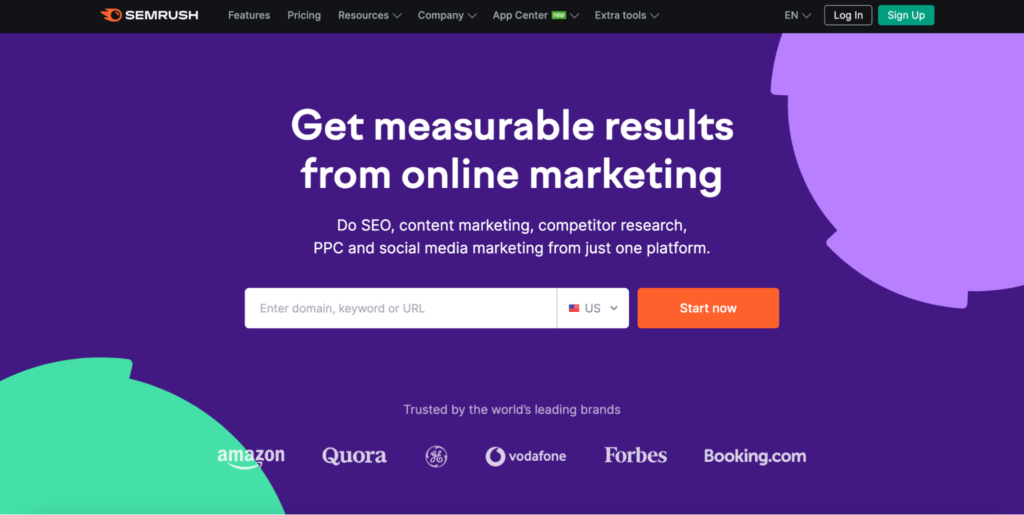
SEMrush is a comprehensive search engine optimization tool with various competitor research features. Its domain overview lets users analyze their competitor’s paid and organic search strategies in-depth.
SEMrush also gathers information on top organic keywords, traffic sources, and backlinks while allowing users to compare their domain with their competitors to identify opportunities and gaps.
Extensive domain overview
SEMrush is popular due to its domain overview feature. It’s a powerful tool enabling users to conduct competitor research by entering their domain. Entering the competitor’s domain gives users access to valuable and exploitable information.
As mentioned, SEMrush offers an in-depth analysis of the target competitor’s paid and organic search strategies. This feature allows users to discover their backlink profile, traffic sources, estimated traffic, and top organic keywords.
The information obtained enables users to identify the keywords their competitors target and assess their overall presence in the online environment.
Keyword research
When it comes to understanding the keyword strategies of your organic competitors, SEMrush’s keyword research tools are an indispensable feature. Its keyword magic tool enables users to unearth the keywords driving traffic to their competitors’ websites.
SEMrush provides invaluable information on keyword difficulty, the competitive landscape for each keyword, and search volume. Users can recognize high-value keywords for targeting and optimizing their content by analyzing the data provided.
Backlink analysis
Backlinks play a critical role in any search engine optimization strategy. SEMrush excels in supplying comprehensive backlink analysis by exploring the backlink profiles of users’ competitors.
By exploring their competitor’s backlink profiles, users can find their most authoritative sources and replicate their successful link-building strategies. SEMrush offers insights into anchor text distribution, the quality of backlinks, and referring domains.
This information assists users in understanding the backlink landscape in their niche and establishing a solid link-building strategy to boost their website’s authority.
Content gap analysis
SEMrush’s content gap feature enables users to recognize gaps in their content strategy compared to their competitors. By comparing their domain with their competitor’s, users can discover which keywords their competitors are ranking for that they are not.
This information allows users to develop new content that focuses on these keywords, improving their visibility in search results. Additionally, SEMrush offers insights into the type of content that performs optimally for their competitors, enabling them to generate relevant and engaging content that resonates with their audience.
Competitor advertising research
SEMrush provides valuable insights into the paid advertising strategies of users’ competitors. Through thorough analysis of their competitors’ paid search campaigns, users can gain valuable insights into the ad copies they are utilizing, the keywords they are bidding on, and their estimated budget.
This information enables users to refine their PPC campaigns, identify opportunities to outperform competitors and optimize their ad copy.
Position tracking
SEMrush’s position tracking feature lets users monitor their competitor’s ranking positions for specific keywords. By tracking their performance over time, users can identify any changes in rankings and adjust their search engine optimization strategies as needed.
Additionally, this tool provides valuable information like keyword difficulty, SERP features, and search volume, assisting users in making informed decisions about their SEO campaigns.
2. Ahrefs
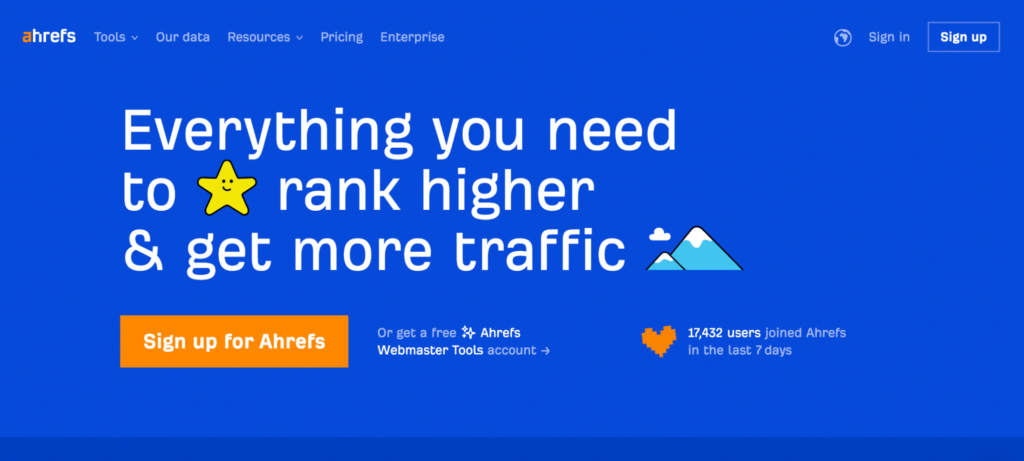
One of the most powerful and popular search engine optimization tools that excels in backlink analysis is Ahrefs. Its competitor research tool analyzes the backlink profiles of users’ competitors, enabling them to identify the most authoritative sources and replicate successful link-building strategies.
Additionally, Ahrefs provides detailed information on ranking positions, content gaps, and organic search keywords. With its wide range of functionalities and features, Ahrefs can provide invaluable insights into the tactics of users’ competitors.
Backlink analysis
One of Ahrefs standout features is its extensive backlink analysis capabilities. As mentioned, backlinks play a pivotal role in search engine rankings, and Ahrefs offers a comprehensive view of the backlink profiles of users’ competitors.
Analyzing these backlinks allows users to identify their competitor’s most authoritative sources and utilize successful link-building strategies for their websites. Ahrefs provides information on the quality of backlinks, anchor text distribution, and referring domains.
Users who obtain this data gain the ability to develop a solid link-building strategy to boost the authority of their website and outrank their competitors.
Keyword research
When attempting to understand your competitors’ keyword strategies, Ahref’s keyword research tools can be an invaluable asset. Ahref’s keyword explorer allows users to discover keywords that drive search traffic to their competitors’ websites.
Ahrefs also provides information on the competitive landscape for each keyword, search volume, and keyword difficulty. This data enables users to recognize high-priority keywords they must target to optimize their content.
Additionally, the “Clicks” metric of Ahrefs estimates the organic traffic potential of specific keywords, assisting users in prioritizing their search engine optimization efforts.
Content analysis
The content analysis features Ahrefs offers allow users to gain insights into the top-performing content of their competitors. Understanding the type of content that resonates with users’ target audience enables them to create relevant, engaging content that stands out.
Ahrefs provides information on specific articles’ estimated traffic, backlinks, and social shares. This data helps users recognize content gaps, enabling them to establish a content strategy that outperforms their competitors.
Competitive analysis
The SEO competitive analysis features of Ahrefs provide a comprehensive look into the SEO strategies of users’ competitors. With Ahref’s site explorer, users can analyze their ranking positions, estimated organic traffic, and top organic keywords.
This data enables users to identify their competitors’ target keywords and asses their online presence. Additionally, Ahrefs provides a comparison feature that allows users to benchmark their website against their competitors, which helps them uncover areas for improvement and opportunities.
Site audit
The site audit tool in Ahrefs enables a user to address and identify technical issues that may affect the performance of their website. Users can ensure they optimize their website for search engines by implementing regular site audits, which result in better rankings.
Ahref’s site audit also provides insights into indexing issues, broken links, and crawlability. Fixing these issues enables users to improve their website’s search engine visibility and overall user experience.
Rank tracking
Ahrefs’ rank tracker feature allows users to monitor the ranking positions of their competitors for specified keywords. Tracking their performance over time allows users to identify shifts in rankings and trends and adjust their SEO strategies based on that information.
Ahrefs also provides viable information on SERP features, search volume, and keyword difficulty, enabling users to make data-driven decisions regarding their SEO campaigns.
3. Moz
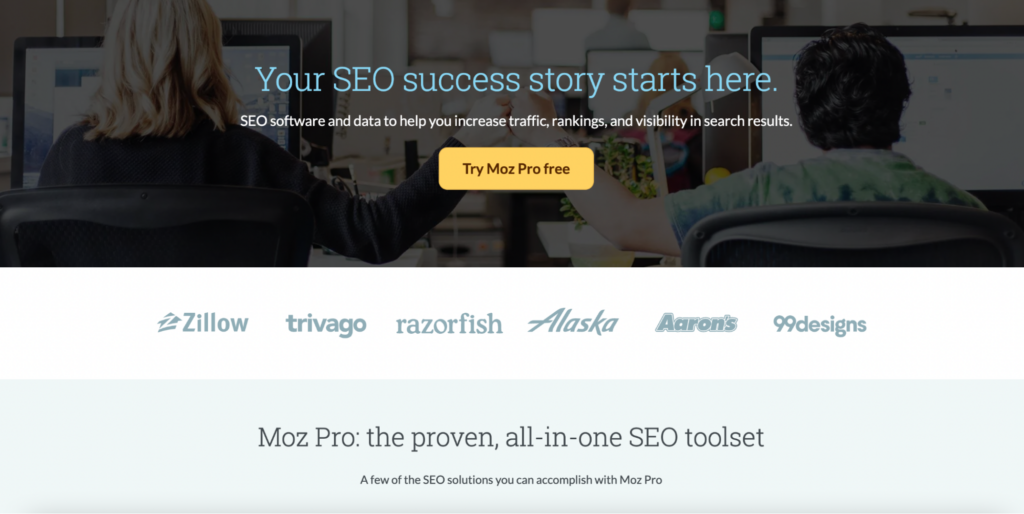
Moz provides a collection of SEO tools, including its competitive link research tool, that is particularly valuable for SEO competitor analysis. This tool enables users to explore their competitors’ anchor text distribution and backlinks to discover opportunities for building high-quality links.
Moz also offers insights into competitors’ page authority and domain authority, helping users understand the overall strength of their competitors’ websites.
Competitive link research
The competitive link research tool is one of the critical features of Moz that enables users to analyze the backlink profiles of their competitors. Examining their competitors’ anchor text distribution, link quality, and link sources allows users to find authoritative sources to replicate and incorporate into their link-building strategies.
This feature assists users in understanding the link landscape in their industry and establishing a solid plan to boost their website’s authority.
Domain authority and page authority analysis
Moz provides a domain authority and page authority metric that measures the quality and strength of a webpage or website. Utilizing Moz’s competitor research tools enables users to assess their competitor’s domain authority and page authority, providing them with insights into the overall strength of their competitors’ websites.
This information allows users to identify strong competitors and understand their positioning in search engine rankings. Analyzing their competitors’ domain authority and page authority enables users to develop strategies that boost their website’s authority and surpass their competitors.
Keyword research and analysis
Moz provides a plethora of tools designed for keyword analysis and research. Understanding competitor keywords enables users to find new opportunities to optimize their content.
Moz’s keyword research tools provide insights into organic click-through rate, keyword difficulty, and search volume. These metrics assist users in prioritizing keywords and optimizing their content to reach higher ranks in search results.
Moz’s Keyword Explorer also enables users to identify related keywords and locate invaluable long-tail keyword opportunities.
On-page optimization
The on-page optimization feature in Moz enables users to analyze the webpage elements of their competitors and find optimization opportunities. Examining their headings, content, and meta tags lets users gain insights into their on-page SEO strategies.
These tools emphasize improvement areas, including poorly optimized titles and missing meta descriptions. That enables users to boost their rankings and refine their on-page optimization.
SERP analysis
Moz provides search engine results page (SERP) analysis tools that assist users in understanding the search landscape for specific keywords. Examining the top-ranking pages for their target keywords enables them to gain insights into the formats, features, and content types that Google favours.
This information allows users to align their content strategy with their target audience’s search intent, giving them a competitive advantage in rankings. The SERP analysis tools also offer information on knowledge panels, featured snippets, and other SERP features that help users optimize their content to maximize exposure.
Content performance analysis
Moz enables users to analyze the performance of their competitor’s content. Understanding the content that resonates with their target audience facilitates the creation of valuable and engaging content that outperforms their competitors.
These tools provide data on engagement metrics, social shares, and backlinks for specific articles. This information helps users see content gaps and establish a content strategy to attract more traffic and earn higher rankings.
4. SpyFu
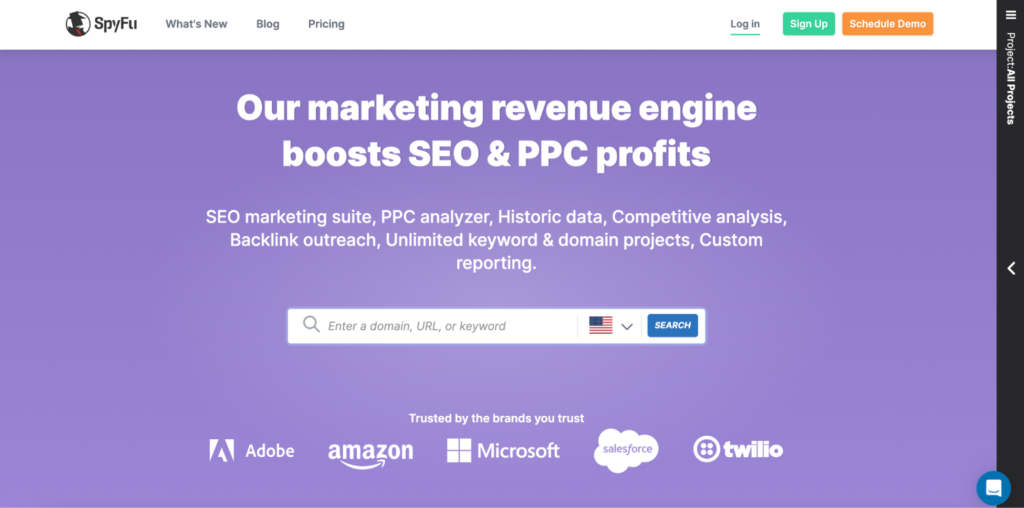
SpyFu is an SEO tool that specializes in competitor keyword analysis. Its competitor keyword spy tool allows users to discover the paid and organic keywords their competitors target.
Additionally, SpyFu provides information on competitors’ ad history, estimated budget, and ranking positions, giving users a comprehensive understanding of their competitors’ PPC strategies. With SpyFu, users can gain critical insights into their competitors’ tactics and find opportunities to boost their SEO efforts.
Competitor analysis
SpyFu’s in-depth competitor analysis allows users to understand the SEO strategies their competitors utilize. SpyFu facilitates the identification of top-paid keywords, ad copy variations, and organic keywords.
This information helps users identify their competitors’ most successful strategies, enabling them to refine their ad and keyword-targeting campaigns.
SpyFu’s competitor analysis also offers insights into competitors’ paid and organic search performance, enabling users to identify areas for improvement and benchmark their website against their competitors.
Keyword research
SpyFu’s keyword research capabilities are crucial in improving organic search rankings and uncovering profitable keywords. With SpyFu, users can find the target keywords of their competitors and evaluate their cost-per-click (CPC), keyword difficulty, and search volume.
Examining this data allows users to recognize high-value keywords with lower competition and optimize their content.
Additionally, SpyFu allows users to track keyword rankings over time, enabling them to monitor their progress and make informed decisions for their SEO campaigns.
Backlink analysis
SpyFu offers backlink analysis tools that assist users in gaining insights into their competitors’ link profiles. With SpyFu, users can analyze their competitors’ anchor text distribution, evaluate the quality of their backlink profiles, and reveal their most authoritative backlinks.
This information helps users develop a robust link-building strategy, improve their website’s authority, and identify potential link-building opportunities.
AdWords competitor research
SpyFu’s AdWords competitor research features can be invaluable for users running pay-per-click (PPC) campaigns. SpyFu enables users to identify their competitors’ most successful ad campaigns, including ad spend, keywords, and ad copies.
By examining their competitors’ strategies, users can obtain insights into effective ad messaging, refine their ad campaigns, and recognize untapped keyword opportunities to accomplish better results and significantly higher click-through rates.
SEO ranking analysis
SpyFu’s SEO ranking analysis features offer critical data on the organic search performance of users’ websites, enabling them to track their rankings over time. SpyFu allows a user to monitor their progress, find fluctuations in rankings, and adjust their SEO strategies based on the given information.
SpyFu also provides insights into the top organic search competitors for users’ target keywords. This feature assists them in understanding the competitive landscape and identifying opportunities for improvement.
Competitor ad history
SpyFu also has a competitor ad history feature that enables users to explore their competitors’ historical PPC ad campaigns. Accessing archived landing pages and ad copies lets users obtain insights into their competitors’ optimization strategies for landing pages and messaging.
This information allows users to learn from the successes and failures of their competitors to create more effective and compelling Google ads and refine their ad campaigns.
5. SimilarWeb
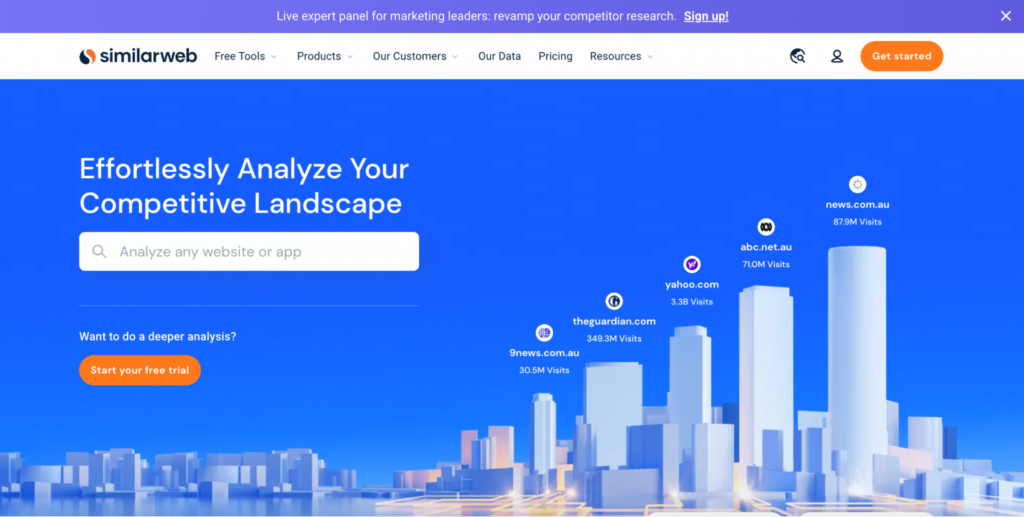
SimilarWeb provides users with valuable insights into their competitors’ audience behaviour and website traffic. Analyzing their referral sites, user demographics, and traffic sources allows users to identify potential opportunities for targeting specific market segments and gain a deeper understanding of their audience.
SimilarWeb also provides information on top-performing engagement and content metrics.
Comprehensive competitor analysis
SimilarWeb offers a comprehensive competitor analysis feature that enables users to gain deep insights into the online performance of their competitors. This tool allows users to identify their top competitors according to traffic volume and engagement metrics.
It allows users to explore their backlink profiles, content marketing strategies and efforts, and paid and organic search strategies.
Traffic sources and channels
Understanding your competitors’ traffic sources is critical to organizing your SEO and marketing campaigns. SimilarWeb provides a detailed breakdown of the traffic sources and channels of users’ competitors.
Users can identify which channels drive the most traffic to their competitors’ websites, which include social media, paid advertising, organic search, and referrals.
Keyword analysis and gap identification
Keywords serve as the backbone of any successful SEO campaign. SimilarWeb offers a comprehensive keyword analysis feature, allowing users to discover which keywords their competitors target to gain higher rankings.
By analyzing this information, users can identify the keyword opportunities and gaps to optimize their content and outrank their competitors. Additionally, SimilarWeb offers suggestions for long-tail and related keywords to expand users’ potential keyword pool.
Content analysis and strategy
Producing high-quality content is critical for SEO success. SimilarWeb helps users in analyzing the content strategies of their competitors. Users can evaluate their competitors’ most popular topics, content formats, and visited pages that generate engagement.
This information helps users understand the strengths and weaknesses of their competitors’ content, enabling them to refine their promotion strategies and content creation.
Benchmarking and goal setting
SimilarWeb allows users to benchmark their website’s performance against competitors’ sites. Users can obtain a clear picture of their position in the market by comparing metrics such as keyword rankings, traffic volume, and engagement.
This data-driven insight enables users to set realistic objectives and monitor their progress.
[info_box id=”2397″]
6. Serpstat

Serpstat provides a wide array of competitor research features, including keyword research, backlink analysis, and domain analysis. These features allow users to explore their competitors’ top paid and organic keywords, find critical backlinks, and identify content gaps they can leverage to outrank them.
Serpstat’s competitive analysis reports provide users with comprehensive insights into the SEO strategies of their competitors.
Comprehensive competitor analysis
Serpstat provides a robust competitor analysis tool that allows users to obtain deep insights into the online performance of their competitors. This tool enables them to identify the top competitors based on various metrics, including keyword rankings, backlink profiles, and organic search visibility.
Serpstat enables users to analyze their competitors’ keyword usage, uncover opportunities, and explore their SEO strategies to outperform them.
Keyword research and analysis
Serpstat offers a keyword research and analysis feature that allows users to identify the industry’s most high-performing and relevant keywords. Users can identify their competitors’ search volumes, the level of completion for each keyword, and their target keywords.
Backlink analysis and building
Serpstat enables users to analyze their competitors’ backlink profiles to identify their most valuable backlinks. Understanding competitors’ linking strategies allows users to reverse engineer successful tactics and gain high-quality backlinks for their websites.
Serpstat also helps identify new link-building opportunities by recommending relevant websites that link to users’ competitors.
Content ideation and optimization
The content ideation feature in Serpstat provides users with topic suggestions based on competitor analysis and keyword research. Users can find popular topics in their niche, develop engaging content that resonates with their target audience, and identify content gaps.
Additionally, Serpstat assists in optimizing users’ existing content by providing insights on content length, keyword usage, and readability.
Rank tracking and reporting
Monitoring keyword rankings and tracking progress is crucial for SEO success. Serpstat provides an extensive rank-tracking feature that allows users to monitor the performance of their website on search engine results pages.
You can keep tabs on your rankings for specific keywords over time, receive automated reports on your SEO progress, and compare your performance against competitors. This data-driven method helps users make informed decisions and optimize their strategies to reach better rankings.
7. BuzzSumo
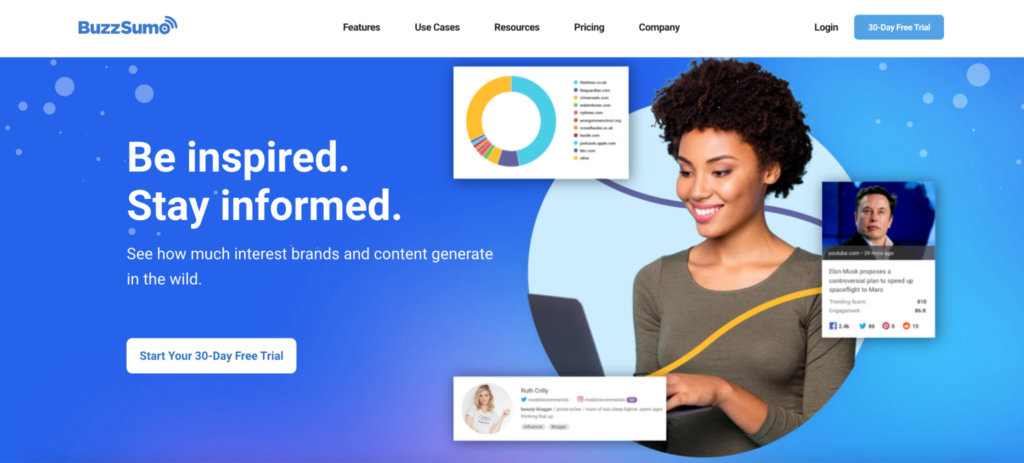
BuzzSumo is a content-focused tool that enables users to analyze their competitors’ most popular content. Discovering their top-performing articles allows users to obtain insights into content types that resonate with their target audience.
Additionally, BuzzSumo provides information on backlinks and social media shares, helping users understand the content’s impact and reach.
Content analysis and performance
BuzzSumo offers a comprehensive content analysis, allowing users to evaluate their competitors’ content performance. Users can determine which content types and topics generate the most backlinks, shares, and social media engagement.
Understanding what content resonates with the target audience enables users to produce similar, high-quality content with a better chance of generating backlinks and attracting organic traffic.
Influencer identification and outreach
Collaborating with influencers in the niche can significantly boost users’ rankings and amplify their content reach. BuzzSumo can assist users in identifying influential individuals who have engaged with or shared their competitors’ content.
Reaching out to these influencers enables users to build relationships, leverage their audience, and gain valuable backlinks to drive more search traffic to their websites.
Topic research and trend identification
Keeping updated with your industry’s latest trends and topics is critical for producing engaging and relevant content. BuzzSumo allows users to research popular topics and identify trending content.
With BuzzSumo, users can find out what content connects with their target audience, which influencers drive engagement in specific topics, and which social media platforms it’s performing well. Aligning content with the latest trends allows users to boost their chances of ranking higher in search engine results and grabbing the attention of their target audience.
Backlink analysis and outreach
BuzzSumo’s backlink analysis feature lets users find which websites frequently link to their competitors’ content. Analyzing these backlinks helps users reach out to relevant websites, secure valuable backlinks for their content, and discover new link-building opportunities.
BuzzSumo offers insights into the quality and authority of these backlinks, enabling users to prioritize their outreach efforts.
Social media monitoring and engagement
Social media plays a critical role in improving brand visibility and driving traffic. BuzzSumo enables users to monitor competitors’ social media engagement and performance metrics.
This information gives a user insights into the content that produces the most engagement, the influencers driving social media discussions, and the platforms competitors find the most success.
Analyzing this data allows users to engage with their audience more effectively, refine their social media strategies, and increase their chances of achieving better rankings.
8. Majestic

Majestic is well-known for its backlink analysis capabilities that provide users with a detailed exploration of their competitors’ backlink profiles, including the number of referring domains, citation flow, and trust flow. Majestic’s tools allow users to evaluate the quality of their backlinks and recognize potential opportunities for link-building campaigns.
Extensive backlink analysis
Majestic provides users with in-depth backlink analysis, allowing them to discover valuable insights into the link profiles of their competitors. Users can analyze the quality and number of backlinks pointing to their competitors’ websites and their anchor text distribution.
Majestic has citation flow and trust flow metrics that help users evaluate their backlink profiles’ overall trustworthiness and authority. Understanding competitors’ link-building strategies enables users to recognize new opportunities for gaining high-quality backlinks and boosting the authority of their websites.
Competitor link gap analysis
Recognizing the gaps in backlink profiles compared to competitors’ is critical to establishing an effective link-building strategy. Majestic’s competitor link gap analysis feature enables users to compare their backlink profiles with those of their competitors.
This feature enables users to identify specific backlinks and domains their competitors have that they lack. This information helps users comprehend which websites to target for link acquisition, bridging the gap and boosting their website’s authority.
Anchor text analysis and link text strategy
Anchor text plays a pivotal role in link building and search engine optimization. Majestic enables users to analyze the anchor text distribution of their competitors, allowing them to identify strategies and patterns employed in link-building campaigns.
Understanding the anchor text landscape within their niche allows users to develop a more effective link text strategy for their website. It also enables them to find opportunities to diversify anchor texts, ensuring a natural and organic link profile.
Historical link data and tracking
Understanding competitors’ historical link data provides valuable insights into their link acquisition strategies over time. Majestic provides historical link data allowing users to track changes in their competitors’ link profiles and recognize link-building trends.
Analyzing historical link data helps users gain insights into successful campaigns and find strategies that have stood the test of time. This information assists users in adapting their link-building efforts for long-term success.
Backlink outreach and relationship building
Building relationships with influencers and website owners is critical for successful link-building. Majestic helps users identify potential link-building opportunities by providing the contact information of website owners.
Users can reach out to the relevant influencers and websites to suggest content or propose collaborations that benefit both parties’ audiences. Users can enhance their relationship-building efforts and secure valuable backlinks for their website by leveraging Majestic’s outreach capabilities.

9. Google Keyword Planner
Google Keyword Planner is a free competitor research tool that assists users in identifying relevant keywords and their search volumes. Simply entering their competitors’ website URLs enables a user to discover the keywords their competitors target and obtain insights into their content strategy.
Extensive keyword research
Google keyword planner offers extensive keyword research capabilities, allowing users to discover keywords relevant to their target audience and industry. Entering a competitor’s site or a seed keyword enables a user to produce a list of related keywords and their average monthly search volumes.
This information helps users understand the demand and popularity of specific keywords, enabling them to optimize their content and target the appropriate keywords to drive organic traffic.
Competitor keyword analysis
Knowing which keywords your competitors target is critical for outperforming them in search engine rankings. Google Keyword Planner enables users to analyze their competitors’ sites to identify the keywords they are bidding on and prioritizing.
Search volume trends and seasonality
Seasonality and search volume trends are pivotal in developing effective SEO strategies. Google Keyword Planner offers insights into the search volume trends for specific keywords in real time.
Analyzing these trends allows users to find peak search periods and adjust their content and digital marketing campaigns accordingly.
Cost-per-click or CPC and competition analysis
Google Keyword Planner provides valuable information on the average cost-per-click or CPC for keywords and the level of completion related to each keyword. Understanding the CPC allows users to gauge the commercial value of specific keywords and focus on those that provide better conversion potential.
Additionally, analyzing the competition level helps users decide which keywords to target and assess the difficulty of ranking for specific keywords in their best SEO campaigns.
Keyword grouping and organization
Organizing keywords into relevant groups is crucial for producing targeted content and optimizing a website’s structure. Google Keyword Planner enables users to create keyword groups based on their shared topics or themes.
This feature helps users categorize and structure content to ensure a comprehensive keyword strategy. Organizing keywords helps users improve their websites’ relevance, search engine rankings, and user experience.
Bonus Tool: Screaming Frog SEO Spider
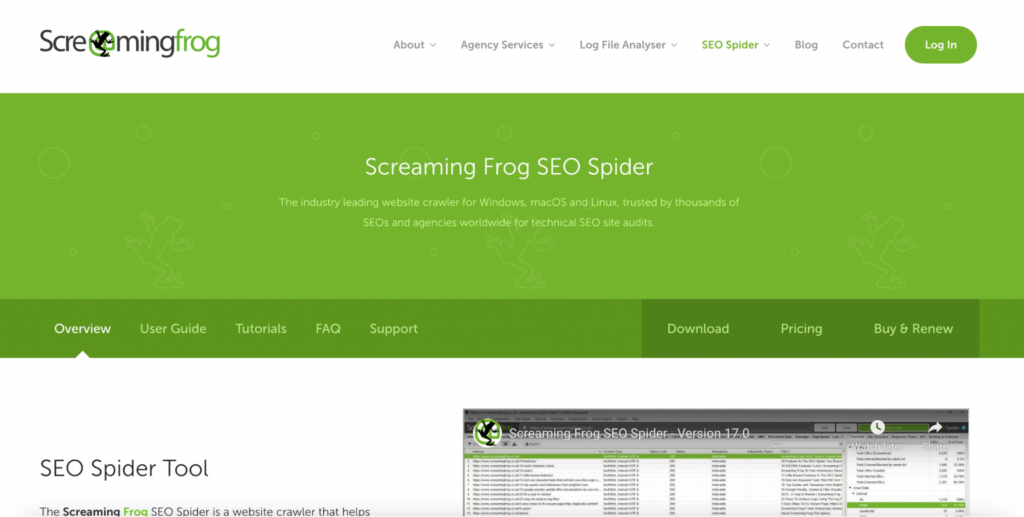
Screaming Frog SEO Spider is a popular website crawler providing users with in-depth insights into their competitors’ on-page SEO. Analyzing their competitors’ headings, meta tags, and other on-page elements enables users to discover optimization opportunities.
This tool also helps users recognize any technical issues on their website, allowing them to address them accordingly.
Comprehensive website crawling
Screaming Frog SEO Spider conducts comprehensive website crawls, allowing users to analyze various aspects of their competitors’ websites. It identifies and reports on vital elements like metadata, URLs, internal and external links, images, and headings.
Analyzing this information allows users to uncover technical issues, optimize their website’s structure, and identify areas for improvement to ensure search engines can efficiently crawl and index their content.
On-page optimization analysis
Screaming Frog SEO Spider offers valuable insights into competitors’ on-page optimization by analyzing key factors, including meta descriptions, keyword usage, title tags, and header tags.
Users can examine their competitors’ on-page optimization techniques to identify areas where their content can improve.
Broken link identification
Broken links can have a massively negative impact on a website’s user experience and search engine rankings. Screaming Frog SEO spider helps users identify broken links on their competitors’ websites, providing them with opportunities to capitalize on those links.
Finding broken links allows users to reach out to the website owner and offer their content as a replacement, enhancing their chances of acquiring valuable backlinks.
Page speed analysis
Page speed significantly affects the overall user experience and search engine rankings. Screaming Frog SEO Spider enables you to analyze your competitors’ page speed and identify potential areas for improvement.
By understanding the factors that impact page speed, such as image sizes, server response times, and caching settings, you can optimize your website for faster load times. Improved page speed enhances user experience and positively influences search engine rankings.
XML sitemap generation
XML sitemaps play a crucial role in assisting search engines in discovering and indexing web pages. Screaming Frog SEO Spider can create XML sitemaps for competitors’ websites, allowing users to analyze their sitemap structure and identify any optimization opportunities or gaps.
Analyzing competitor sitemaps enables users to optimize their XML sitemaps to ensure they include all relevant pages and are easily detectable by search engines.
Competitive analysis tools and reporting
Screaming Frog SEO Spider lets users compare their website’s performance and optimization with their competitors. By implementing a comprehensive competitive analysis, users can identify aspects their competitors excel at and leverage their strategies for improvement.
Get Ahead of Your Competitors With These Competitor Research Tools
Effective competitor research is a critical component of any successful SEO strategy. These nine competitor research tools offer valuable insights that can give you a competitive advantage.
If you require assistance navigating these competitor research tools, it is ideal to consult SEO experts like SearchEye to maximize their potential. You can find your competitors’ keywords, content strategies, backlinks, and more with these tools.
Need more help staying ahead of your competitors? SearchEye is your one-stop shop for SEO essentials such as advanced deliverables, keyword research, and link-building services.
[faq_post id=”2396″]

